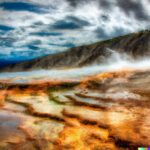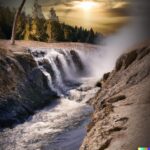Geysers, those captivating natural wonders that shoot hot water and steam into the air, play a crucial role in Yellowstone’s unique ecosystem. But have you ever wondered how these geysers form or what different types can be found in the park?
In this article, we will explore the impact of geysers on Yellowstone’s ecosystem, including their contribution to nutrient cycling, habitat creation, thermal regulation, and biodiversity. We will also discuss the threats posed by human interference, such as geothermal energy extraction and pollution, and the conservation efforts being made to protect these natural marvels.
So, join us as we dive into the fascinating world of geysers in Yellowstone National Park.
What is a Geyser?
A geyser is a natural hydrothermal feature found in geothermal areas like Yellowstone National Park, characterized by intermittent eruptions of hot water and steam due to underground volcanic activity.
These fascinating natural phenomena are known for their unpredictable eruption patterns, shooting jets of boiling water and steam into the air. Geysers form when underground water encounters heated rocks, causing it to boil and create pressure until it bursts through the surface.
Yellowstone National Park is home to some of the world’s most famous geysers, including Old Faithful, which draws in crowds with its regular and spectacular displays. The sight of a geyser erupting is a truly mesmerizing experience, highlighting the raw power and beauty of nature’s forces at play.
The Role of Geysers in Yellowstone’s Ecosystem
Geysers play a crucial role in Yellowstone’s ecosystem by contributing to its thermal features, supporting biodiversity, and providing essential geothermal ecosystem services that maintain ecological balance and health.
How Do Geysers Form?
Geysers form through a combination of geothermal heat, geological processes, and intricate geothermal interactions that result in the buildup of pressure and the eventual expulsion of hot water and steam.
Geothermal heat plays a crucial role in geyser formation, with underground heat causing the water to boil and rise toward the surface. This heat source originates from the Earth’s molten core and the heat generated by the decay of radioactive elements within the planet. As the water nears the surface, geological features such as fractures and conduits create pathways for the pressurized water and steam to travel. These interactions between heat, water, and geological structures create the perfect conditions for geyser eruptions.
What are the Different Types of Geysers in Yellowstone?
Yellowstone showcases various types of geysers, each exhibiting unique geothermal features, hotspots, and formations that contribute to the diverse geothermal landscape of the region.
From the iconic Old Faithful, which shoots water up to 180 feet in the air with remarkable regularity, to the multicolored Morning Glory Pool, known for its stunning rainbow hues, visitors to Yellowstone National Park are treated to a mesmerizing display of nature’s thermal wonders.
The park’s geysers range from cone geysers like Castle Geyser to fountain geysers like Great Fountain Geyser, each representing a different manifestation of geothermal activity. These geological marvels serve as a testament to the raw power and creativity of Yellowstone’s underground thermal features.
How Do Geysers Affect the Ecosystem?
Geysers impact the ecosystem by promoting microbial life, enhancing nutrient cycling, and contributing to thermal regulation, resulting in improved ecosystem health and balance.
Nutrient Cycling
Nutrient cycling facilitated by geysers involves the transfer of essential elements and compounds between thermal pools, influenced by the unique geothermal geology and ecosystems present in geysering areas.
These geothermal ecosystems play a crucial role in recycling nutrients through a series of interconnected processes. Thermal pools serve as hotspots for microbial activity, where thermophilic bacteria break down organic matter and release nutrients back into the environment.
This breakdown of organic material not only releases nutrients like nitrogen and phosphorus but also fuels the production of new organic matter in the ecosystem. The geological characteristics of geysers, such as the presence of hydrothermal vents, further contribute to the nutrient dynamics by releasing minerals into the surrounding soil and water.
Habitat Creation
Geysers contribute to habitat creation by establishing unique geothermal habitats that harbor diverse flora and fauna, showcasing the importance of geothermal resources in sustaining biodiversity.
These geothermal habitats provide a specialized environment that supports a variety of organisms adapted to extreme conditions. From thermophiles thriving in the steaming waters to algae and mosses taking advantage of the mineral-rich soil, geothermal habitats host a wide array of life forms. Insects, birds, and even small mammals are also attracted to these areas, creating a balanced ecosystem where each species plays a crucial role in the intricate web of life. This rich biodiversity in geothermal habitats highlights the resilience and adaptability of life in challenging environments.
Thermal Regulation
Geysers contribute to thermal regulation by releasing geothermal heat and energy into the environment, playing a crucial role in maintaining thermal balance within the geothermal ecosystem.
This process of heat release from geysers helps in stabilizing temperatures and preventing extreme fluctuations in the surrounding area. Through the continuous emission of hot water and steam, geysers effectively dissipate thermal energy, preventing overheating in the geothermal ecosystem. This natural regulation of temperature is vital for the survival of unique geothermal flora and fauna, which have adapted to the specific thermal conditions of these environments.
The impact of geothermal heat on the environment extends beyond local ecosystems, influencing climate patterns and contributing to the overall balance of thermal energy on a larger scale.
Biodiversity
Geysers foster biodiversity by supporting a wide range of wildlife, plant life, and specialized microorganisms that thrive in geothermal habitats, contributing to the rich tapestry of geothermal biodiversity.
This unique ecosystem provided by geysers creates a haven for diverse species such as thermophiles, unique algae, and rare plants that have adapted to the extreme conditions of hot water and steam. These specialized organisms form intricate food webs, supporting a delicate balance that sustains the overall health of the geothermal ecosystem. The hot springs and geysers play a crucial role in maintaining the nutrient cycle, providing essential elements for the growth of various plant species that are crucial for the survival of the entire ecosystem.
The Impact of Human Interference on Geysers in Yellowstone
Human interference in the form of geothermal energy extraction poses significant environmental impacts on geysers in Yellowstone, necessitating stringent geothermal conservation measures to safeguard these natural wonders.
Geothermal Energy Extraction
Geothermal energy extraction, while a valuable renewable resource, can disrupt geysers by depleting geothermal resources and altering geothermal landscapes, prompting the need for extensive geothermal research to mitigate its impacts.
When geothermal energy is extracted from underground reservoirs, it can lead to a decrease in pressure within the reservoir, impacting the natural flow of geysers. This disturbance can cause changes in geyser activity, such as reduced eruptions or even complete cessation. The depletion of geothermal resources through excessive extraction can result in long-term damage to the geothermal ecosystem and surrounding landscapes.
Geothermal research is essential for understanding the intricate balance of geothermal systems and developing sustainable practices to preserve these valuable natural resources.
Pollution and Waste
Pollution and waste generated from human activities can lead to adverse geothermal impacts, underscoring the necessity of implementing robust geothermal protection measures to mitigate environmental harm and preserve geysers.
Geysers, like those in Yellowstone National Park, are particularly vulnerable to pollution and waste contamination, as these natural phenomena rely on pristine conditions. When pollutants seep into the underground reservoirs feeding geysers, it can alter their delicate ecosystems, affecting water quality and potentially disrupting their eruption cycles. Such disturbances not only harm the geysers themselves but also have broader repercussions on the surrounding geothermal systems and biodiversity.
Therefore, it becomes imperative to establish and enforce effective protective strategies to ensure the long-term sustainability of these unique geothermal features.
Damage to Geyser Cones
Damage to geyser cones due to human interference can disrupt geothermal dynamics and ecological functions, necessitating comprehensive geothermal restoration efforts to repair the damage and restore the natural balance.
When human activities encroach upon these delicate geothermal areas, such as trampling on the fragile cone formations or introducing foreign substances, the intricate balance of the geothermal ecosystem can be thrown off. This disruption not only impacts the geological processes at play but also has cascading effects on the surrounding ecological communities. Without intervention and restoration initiatives, the damage inflicted on these geyser cones can lead to irreversible harm to the geothermal dynamics and the biodiversity that depends on these unique habitats.
Conservation Efforts and Management of Geysers in Yellowstone
Conservation efforts and management strategies play a pivotal role in preserving geysers in Yellowstone, encompassing dedicated geothermal conservation programs, meticulous monitoring practices, and responsible geothermal stewardship.
Geyser Protection Laws
Geyser protection laws are crucial in recognizing the significance of geothermal features, promoting geothermal education, and ensuring legal frameworks to safeguard these invaluable natural assets.
These legislative measures play a vital role in preserving not only the mesmerizing beauty of geysers but also the underlying geothermal value that fuels them. By establishing guidelines that restrict harmful practices near these geological wonders, such as drilling or construction, the laws ensure that the unique ecosystem surrounding geysers remains intact. Geothermal education initiatives are key in fostering public understanding of the importance of these natural wonders, ultimately leading to increased appreciation and responsible behavior towards geothermal areas.
Monitoring and Research
Continuous monitoring and research efforts are essential for understanding geothermal dynamics, raising geothermal awareness, and implementing informed conservation strategies to safeguard geysers for future generations.
By conducting thorough research, scientists can delve into the intricate processes behind geothermal activities, shedding light on factors influencing geyser behavior. This knowledge aids in the creation of targeted conservation plans that cater to the specific needs of these unique geothermal sites.
Increased geothermal awareness among the public is crucial for garnering support and resources for conservation efforts, showcasing the significance of preserving these natural wonders. Research plays a significant role in developing innovative techniques and technologies that help in monitoring geothermal areas effectively, ensuring their sustainable preservation for the benefit of both the environment and future generations.
Education and Awareness
Educational initiatives play a vital role in promoting geothermal sustainability, enhancing public awareness of geothermal impacts, and fostering a culture of responsible stewardship towards geysers and geothermal resources.
By equipping individuals with knowledge about the benefits of harnessing geothermal energy in sustainable ways, educational programs can empower communities to make informed choices that contribute to preserving these valuable natural resources.
Understanding the environmental implications of geothermal development is crucial for developing strategies that minimize negative impacts on ecosystems and local communities.
Education also serves as a catalyst for encouraging innovation and technological advancements in geothermal energy production, paving the way for more efficient and environmentally friendly practices.
Last Updated on February 7, 2024 by Jon Waraas – Originally Posted: February 6, 2024

I’m Jon Waraas, and I’ve been navigating the online world since 2006. By day, I’m the proud owner of some eCommerce gems, and by night, I’m the voice behind the adventures on Waraas.Com.
My heart, however, belongs to the wild beauty of Yellowstone National Park. I’ve got a collection of websites dedicated to sharing the wonders of this natural masterpiece. Oh, and did I mention? I’m currently building my own cabin inside the ghost town of Gilmore, Idaho – a cabin with tales to tell!
When I’m not immersed in the digital realm, you’ll find me lacing up my boots for a good hike or setting up camp under the star-studded sky.




